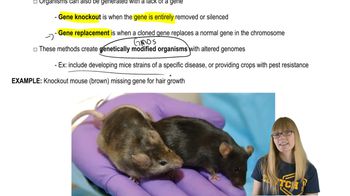Table of contents
- 1. Introduction to Genetics51m
- 2. Mendel's Laws of Inheritance3h 37m
- 3. Extensions to Mendelian Inheritance2h 41m
- 4. Genetic Mapping and Linkage2h 28m
- 5. Genetics of Bacteria and Viruses1h 21m
- 6. Chromosomal Variation1h 48m
- 7. DNA and Chromosome Structure56m
- 8. DNA Replication1h 10m
- 9. Mitosis and Meiosis1h 34m
- 10. Transcription1h 0m
- 11. Translation58m
- 12. Gene Regulation in Prokaryotes1h 19m
- 13. Gene Regulation in Eukaryotes44m
- 14. Genetic Control of Development44m
- 15. Genomes and Genomics1h 50m
- 16. Transposable Elements47m
- 17. Mutation, Repair, and Recombination1h 6m
- 18. Molecular Genetic Tools19m
- 19. Cancer Genetics29m
- 20. Quantitative Genetics1h 26m
- 21. Population Genetics50m
- 22. Evolutionary Genetics29m
14. Genetic Control of Development
Developmental Patterning Genes
Problem 19a
Textbook Question
The apterous gene in Drosophila encodes a protein required for wing patterning and growth. It is also known to function in nerve development, fertility, and viability. When human and mouse genes whose protein products closely resemble apterous were used to generate transgenic Drosophila [Rincon-Limas et al. (1999). Proc. Nat. Acad. Sci. (USA) 96:2165–2170], the apterous mutant phenotype was rescued. In addition, the whole-body expression patterns in the transgenic Drosophila were similar to normal apterous.
What is meant by the term rescued in this context?
 Verified step by step guidance
Verified step by step guidance1
Understand that in genetics, the term 'rescued' refers to the restoration of a normal phenotype in an organism that has a mutation causing a defective or altered trait.
In this context, the apterous gene mutation in Drosophila causes defects in wing patterning, nerve development, fertility, and viability, leading to an abnormal phenotype.
When human and mouse genes similar to apterous are introduced into the mutant Drosophila, these genes produce proteins that can perform the function of the missing or defective apterous protein.
The term 'rescued' means that the introduction of these foreign genes compensates for the mutation, restoring the normal wing patterning and other functions, effectively reversing the mutant phenotype.
Therefore, 'rescued' indicates that the mutant phenotype caused by the defective apterous gene is corrected or alleviated by the expression of the homologous genes from other species.
 Verified video answer for a similar problem:
Verified video answer for a similar problem:This video solution was recommended by our tutors as helpful for the problem above
Video duration:
2mPlay a video:
Was this helpful?
Key Concepts
Here are the essential concepts you must grasp in order to answer the question correctly.
Gene Rescue
Gene rescue refers to the restoration of a normal phenotype in an organism that has a mutant gene, by introducing a functional copy of that gene or a similar gene. In this context, it means that the mutant Drosophila lacking functional apterous protein regained normal wing patterning and other functions when human or mouse homologs were expressed.
Recommended video:
Guided course

Mapping Genes
Homologous Genes and Functional Conservation
Homologous genes are genes in different species that evolved from a common ancestor and often retain similar functions. The ability of human and mouse genes to rescue the Drosophila apterous mutant indicates functional conservation, meaning these genes produce proteins that can substitute for each other across species.
Recommended video:
Guided course

Functional Genomics
Transgenic Organisms
Transgenic organisms are genetically modified to carry genes from other species. In this case, Drosophila were engineered to express human and mouse genes, allowing researchers to study gene function and cross-species gene compatibility by observing phenotypic changes.
Recommended video:
Guided course

Transgenic Organisms and Gene Therapy
Related Videos
Related Practice
Textbook Question
The bristles that develop from the epidermis in Drosophila are evenly spaced, so that two bristles never occur immediately adjacent to each other. How might this pattern be established during development?
393
views


